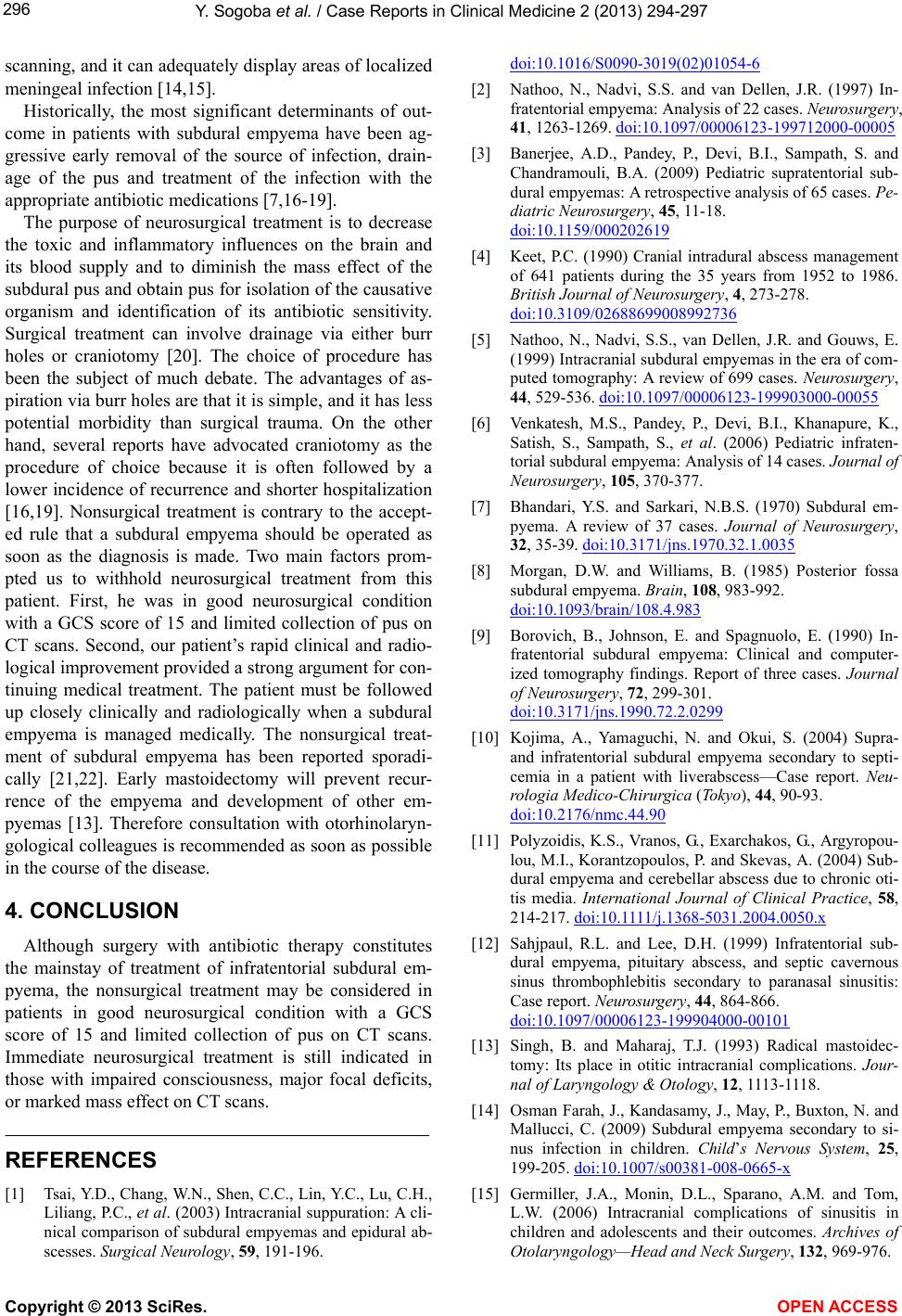
Y. Sogoba et al. / Case Reports in Clinica l Me dicine 2 (2013) 294-297
296
scanning, and it can adequately display areas of localized
meningeal infection [14,15].
Historically, the most significant determinants of out-
come in patients with subdural empyema have been ag-
gressive early removal of the source of infection, drain-
age of the pus and treatment of the infection with the
appropriate antibiotic medications [7,16-19].
The purpose of neurosurgical treatment is to decrease
the toxic and inflammatory influences on the brain and
its blood supply and to diminish the mass effect of the
subdural pus and ob tain pus for isolation of the causative
organism and identification of its antibiotic sensitivity.
Surgical treatment can involve drainage via either burr
holes or craniotomy [20]. The choice of procedure has
been the subject of much debate. The advantages of as-
piration via burr holes are that it is simple, and it h as less
potential morbidity than surgical trauma. On the other
hand, several reports have advocated craniotomy as the
procedure of choice because it is often followed by a
lower incidence of recurr ence and shorter hospitalization
[16,19]. Nonsurgical treatment is contrary to the accept-
ed rule that a subdural empyema should be operated as
soon as the diagnosis is made. Two main factors prom-
pted us to withhold neurosurgical treatment from this
patient. First, he was in good neurosurgical condition
with a GCS score of 15 and limited collection of pus on
CT scans. Second, our patient’s rapid clinical and radio-
logical improve ment prov id ed a strong argument for con-
tinuing medical treatment. The patient must be followed
up closely clinically and radiologically when a subdural
empyema is managed medically. The nonsurgical treat-
ment of subdural empyema has been reported sporadi-
cally [21,22]. Early mastoidectomy will prevent recur-
rence of the empyema and development of other em-
pyemas [13]. Therefore consultation with otorhinolaryn-
gological colleagues is recommended as soon as possible
in the course of the disease.
4. CONCLUSION
Although surgery with antibiotic therapy constitutes
the mainstay of treatment of infratentorial subdural em-
pyema, the nonsurgical treatment may be considered in
patients in good neurosurgical condition with a GCS
score of 15 and limited collection of pus on CT scans.
Immediate neurosurgical treatment is still indicated in
those with impaired consciousness, major focal deficits,
or marked mass effect on CT scans.
REFERENCES
[1] Tsai, Y.D., Chang, W.N., Shen, C.C., Lin, Y.C., Lu, C.H.,
Liliang, P.C., et al. (2003) Intracranial suppuration: A cli-
nical comparison of subdural empyemas and epidural ab-
scesses. Surgical Neurology, 59, 191-196.
doi:10.1016/S0090-3019(02)01054-6
[2] Nathoo, N., Nadvi, S.S. and van Dellen, J.R. (1997) In-
fratentorial empyema: Analysis of 22 cases. Neurosurgery,
41, 1263-1269. doi:10.1097/00006123-199712000-00005
[3] Banerjee, A.D., Pandey, P., Devi, B.I., Sampath, S. and
Chandramouli, B.A. (2009) Pediatric supratentorial sub-
dural empyemas: A retrospective analysis of 65 cases. Pe-
diatric Neurosurgery, 45, 11-18.
doi:10.1159/000202619
[4] Keet, P.C. (1990) Cranial intradural abscess management
of 641 patients during the 35 years from 1952 to 1986.
British Journal of Neurosurg ery, 4, 273-278.
doi:10.3109/02688699008992736
[5] Nathoo, N., Nadvi, S.S., van Dellen, J.R. and Gouws, E.
(1999) Intracranial subdural empyemas in the era of com-
puted tomography: A review of 699 cases. Neurosurgery,
44, 529-536. doi:10.1097/00006123-199903000-00055
[6] Venkatesh, M.S., Pandey, P., Devi, B.I., Khanapure, K.,
Satish, S., Sampath, S., et al. (2006) Pediatric infraten-
torial subdural empyema: Analysis of 14 cases. Journal of
Neurosurgery, 105, 370-377.
[7] Bhandari, Y.S. and Sarkari, N.B.S. (1970) Subdural em-
pyema. A review of 37 cases. Journal of Neurosurgery,
32, 35-39. doi:10.3171/jns.1970.32.1.0035
[8] Morgan, D.W. and Williams, B. (1985) Posterior fossa
subdural empyema. Brain, 108, 983-992.
doi:10.1093/brain/108.4.983
[9] Borovich, B., Johnson, E. and Spagnuolo, E. (1990) In-
fratentorial subdural empyema: Clinical and computer-
ized tomography findings. Report of three cases. Journal
of Neurosurgery, 72, 299-301.
doi:10.3171/jns.1990.72.2.0299
[10] Kojima, A., Yamaguchi, N. and Okui, S. (2004) Supra-
and infratentorial subdural empyema secondary to septi-
cemia in a patient with liverabscess—Case report. Neu-
rologia Medico-Chirurgica (Tokyo), 44, 90-93.
doi:10.2176/nmc.44.90
[11] Polyzoidis, K.S., Vranos, G., Exarchakos, G., Argyropou-
lou, M.I., Korantzopoulos, P. and Skevas, A. (2004) Sub-
dural empyema and cerebellar abscess due to chronic oti-
tis media. International Journal of Clinical Practice, 58,
214-217. d oi :10.1111/j.1368-5031.2004.0050.x
[12] Sahjpaul, R.L. and Lee, D.H. (1999) Infratentorial sub-
dural empyema, pituitary abscess, and septic cavernous
sinus thrombophlebitis secondary to paranasal sinusitis:
Case report. Neurosurgery, 44, 864-866.
doi:10.1097/00006123-199904000-00101
[13] Singh, B. and Maharaj, T.J. (1993) Radical mastoidec-
tomy: Its place in otitic intracranial complications. Jour-
nal of Laryngology & Otology, 12, 1113-1118.
[14] Osman Farah, J., Kandasamy, J., May, P., Buxton, N. and
Mallucci, C. (2009) Subdural empyema secondary to si-
nus infection in children. Child’s Nervous System, 25,
199-205. doi:10.1007/s00381-008-0665-x
[15] Germiller, J.A., Monin, D.L., Sparano, A.M. and Tom,
L.W. (2006) Intracranial complications of sinusitis in
children and adolescents and their outcomes. Archives of
Otolaryngology—Head and Neck Surgery, 132, 969-976.
Copyright © 2013 SciRes. OPEN ACCESS